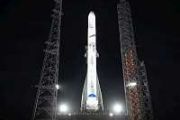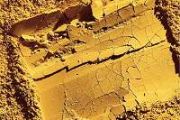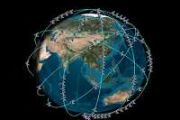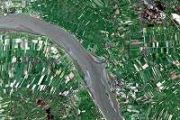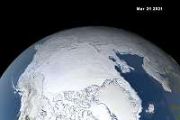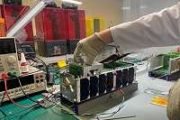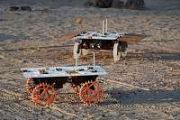
Copernical Team
New ice is like a snapshot of liquid water
 A collaboration between scientists at Cambridge and UCL has led to the discovery of a new form of ice that more closely resembles liquid water than any other and may hold the key to understanding this most famous of liquids.
The new form of ice is amorphous. Unlike ordinary crystalline ice where the molecules arrange themselves in a regular pattern, in amorphous ice the molecules are in a
A collaboration between scientists at Cambridge and UCL has led to the discovery of a new form of ice that more closely resembles liquid water than any other and may hold the key to understanding this most famous of liquids.
The new form of ice is amorphous. Unlike ordinary crystalline ice where the molecules arrange themselves in a regular pattern, in amorphous ice the molecules are in a Ghostly mirrors for high-power lasers
 The 'mirrors' exist for only a fragment of time but could help to reduce the size of ultra-high power lasers, which currently occupy buildings the size of aircraft hangars, to university basement sizes.
They have potential to be developed into a variety of plasma-based, high damage-threshold optical elements that could lead to small footprint, ultra-high-power, ultra-short pulse laser syst
The 'mirrors' exist for only a fragment of time but could help to reduce the size of ultra-high power lasers, which currently occupy buildings the size of aircraft hangars, to university basement sizes.
They have potential to be developed into a variety of plasma-based, high damage-threshold optical elements that could lead to small footprint, ultra-high-power, ultra-short pulse laser syst Scientists track tropical landslide creeping below an African city
 Creeping from just a finger's width up to a few feet per year, slow-moving landslides occur naturally throughout the world. They typically are detected inching downslope in rocky areas with high seasonal precipitation and clay-rich soil, and they can take months to years - even centuries - to develop. Yet they can also bring sudden violence. Thousands of landslides are flowing, slipping, topplin
Creeping from just a finger's width up to a few feet per year, slow-moving landslides occur naturally throughout the world. They typically are detected inching downslope in rocky areas with high seasonal precipitation and clay-rich soil, and they can take months to years - even centuries - to develop. Yet they can also bring sudden violence. Thousands of landslides are flowing, slipping, topplin IBM and NASA collaborate to research impact of climate change with AI
 IBM (NYSE: IBM) and NASA's Marshall Space Flight Center have announced a collaboration to use IBM's artificial intelligence (AI) technology to discover new insights in NASA's massive trove of Earth and geospatial science data. The joint work will apply AI foundation model technology to NASA's Earth-observing satellite data for the first time.
Foundation models are types of AI models that a
IBM (NYSE: IBM) and NASA's Marshall Space Flight Center have announced a collaboration to use IBM's artificial intelligence (AI) technology to discover new insights in NASA's massive trove of Earth and geospatial science data. The joint work will apply AI foundation model technology to NASA's Earth-observing satellite data for the first time.
Foundation models are types of AI models that a AFRL partners with NASA in cubesat navigation, communication mission
 The Air Force Research Laboratory's, or AFRL, newest sensor experiment deployed from the International Space Station Dec. 29, 2022, hosted on NASA's six-unit cube satellite named petitSat, or Plasma Enhancements in the Ionosphere-Thermosphere Satellite.
The CubeSat's mission is to study a layer in Earth's upper atmosphere known as the ionosphere to provide insight into space weather distur
The Air Force Research Laboratory's, or AFRL, newest sensor experiment deployed from the International Space Station Dec. 29, 2022, hosted on NASA's six-unit cube satellite named petitSat, or Plasma Enhancements in the Ionosphere-Thermosphere Satellite.
The CubeSat's mission is to study a layer in Earth's upper atmosphere known as the ionosphere to provide insight into space weather distur OneWeb and Kazakhstan National Railways to work together
 OneWeb, a company specializing in low Earth orbit satellite communications, has signed a Memorandum of Understanding (MoU) with the Kazakhstan National Railways Company "Kazakhstan Temir Zholy" to investigate providing high-speed, low-latency broadband satellite connectivity to railway stations and rolling stock throughout Kazakhstan.
This collaboration aims to enhance the connectivity and
OneWeb, a company specializing in low Earth orbit satellite communications, has signed a Memorandum of Understanding (MoU) with the Kazakhstan National Railways Company "Kazakhstan Temir Zholy" to investigate providing high-speed, low-latency broadband satellite connectivity to railway stations and rolling stock throughout Kazakhstan.
This collaboration aims to enhance the connectivity and Sidus Space closes public offering
 Sidus Space, Inc. (Nasdaq: SIDU), reported Friday the closing of its underwritten public offering of 17,250,000 shares of its Class A common stock (or pre-funded warrants (the "Pre-Funded Warrants") in lieu thereof, which included the full exercise of the underwriters' over-allotment option.
Each share of Class A common stock was sold to the public at a price of $0.30 per share. The gross
Sidus Space, Inc. (Nasdaq: SIDU), reported Friday the closing of its underwritten public offering of 17,250,000 shares of its Class A common stock (or pre-funded warrants (the "Pre-Funded Warrants") in lieu thereof, which included the full exercise of the underwriters' over-allotment option.
Each share of Class A common stock was sold to the public at a price of $0.30 per share. The gross Poland's SatRev signs on for future Virgin Orbit flights
 Virgin Orbit (NASDAQ: VORB) and Poland-based satellite manufacturer SatRev announced a follow-on launch services agreement (LSA) for additional launches of SatRev's satellites in 2023 and beyond.
This new agreement provides SatRev with the flexibility to launch 500 kg over multiple launches to a variety of different orbital planes from the Mojave Air and Space Port in California, USA and/o
Virgin Orbit (NASDAQ: VORB) and Poland-based satellite manufacturer SatRev announced a follow-on launch services agreement (LSA) for additional launches of SatRev's satellites in 2023 and beyond.
This new agreement provides SatRev with the flexibility to launch 500 kg over multiple launches to a variety of different orbital planes from the Mojave Air and Space Port in California, USA and/o A nearby potentially habitable Earth-mass exoplanet
 A team of astronomers led by MPIA scientist Diana Kossakowski have discovered an Earth-mass exoplanet orbiting in the habitable zone of the red dwarf star Wolf 1069. Although the rotation of this planet, named Wolf 1069 b, is probably tidally locked to its path around the parent star, the team is optimistic it may provide durable habitable conditions across a wide area of its dayside. The absenc
A team of astronomers led by MPIA scientist Diana Kossakowski have discovered an Earth-mass exoplanet orbiting in the habitable zone of the red dwarf star Wolf 1069. Although the rotation of this planet, named Wolf 1069 b, is probably tidally locked to its path around the parent star, the team is optimistic it may provide durable habitable conditions across a wide area of its dayside. The absenc Cloudy Sols Are Here Again
 Mars clouds are very much like Earth's cirrus clouds but thinner. While Earth clouds can contain liquid water, the low temperatures and pressures on Mars only allow for water-ice (and CO2 ice) clouds to form. However, these water-ice clouds are optically thin because of the low amounts of water present in the Martian atmosphere; if all the water were on the surface, it would make a layer thinner
Mars clouds are very much like Earth's cirrus clouds but thinner. While Earth clouds can contain liquid water, the low temperatures and pressures on Mars only allow for water-ice (and CO2 ice) clouds to form. However, these water-ice clouds are optically thin because of the low amounts of water present in the Martian atmosphere; if all the water were on the surface, it would make a layer thinner 







